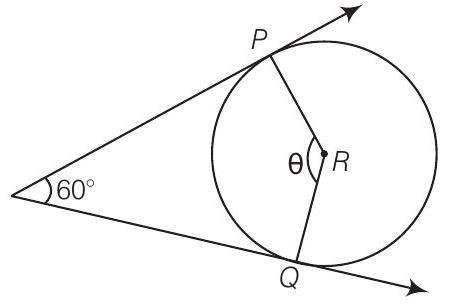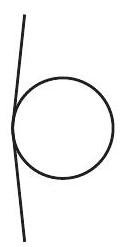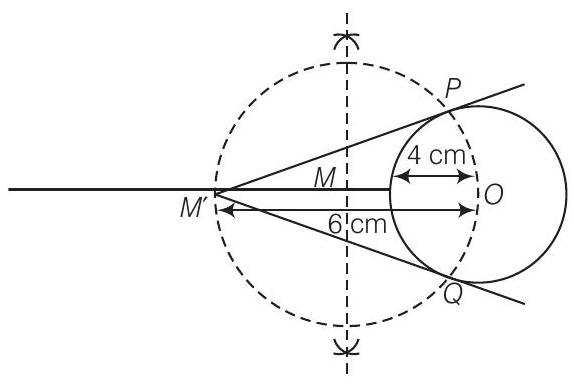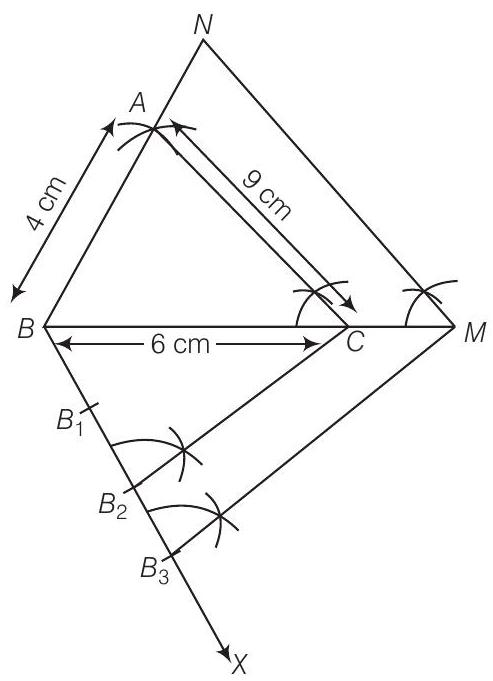Chapter 10 Constructions
Multiple Choice Questions (MCQs)
1 To divide a line segment
(a) 8
Show Answer
Solution
(d) We know that, to divide a line segment
Here,
So, minimum number of these points
(a)
Show Answer
Solution
(b) Here, minimum
(a)
(c)
Show Answer
Solution
(a) Given, a line segment

Steps of construction
-
Draw a ray
-
Draw a ray
-
Now, locate the points
-
Join
Then,
(a)
(c)
Show Answer
Solution
(c) Here, we locate points
(a) 5
Show Answer
Solution
(b) To construct a triangle similar to a given triangle, with its sides
Here,
So, the minimum number of point to be located at equal distance on ray
(a)
Show Answer
Solution
(d) The angle between them should be

From figure it is quadrilateral,
Hence, the required angle between them is
Vert Short Answer Type Questions
1 By geometrical construction, it is possible to divide a line segment in the ratio
Show Answer
Solution
True
Given,
So,
Hence, the geometrical construction is possible to divide a line segment in the ratio
Show Answer
Solution
False
Steps of construction
-
Draw a line segment
-
Taking
-
Join
-
From
-
Locate seven points
-
Join
-
From point
Then,
Given that, segment
Thinking Process
Let
(i) If
(ii) If
(iii) If
Show Answer
Solution
False
Since, the radius of the circle is
We see that,
i.e., a point
Show Answer
Thinking Process
If the angle between pair of tangents is greater than
Solution
True
If the angle between the pair of tangents is always greater than 0 or less than
Hence, we can drawn a pair of tangents to a circle inclined at an angle of

Short Answer Type Questions
1 Draw a line segment of length
Show Answer
Solution
Steps of construction
-
Draw a line segment
-
Draw a ray
-
Along
- Join
- From
[by making an angle equal to
Then,
Thus,
Justification

Let
In
Show Answer
Thinking Process
Here, Scale factor
Solution
Steps of construction
-
Draw a line segment
-
From

- Join
- From
- On ray
- Join
- From point
- From point
Show Answer
Thinking Process
Here, scale factor
Solution
Steps of construction
-
Draw a line segment
-
Taking
-
Join
-
From
-
Mark five points

-
Join
-
From point
Then,
Hence,
Show Answer
Thinking Process
(i) Firstly taking the perpendicular bisector of the distance from the centre to the external point. After that taking one half of bisector as radius and draw a circle.
(ii) Drawing circle intersect the given circle at two points. Now, meet these intersecting points to an external point and get the required tangents.
Solution
Given, a point
Steps of construction
-
Draw a circle of radius
-
Join
-
Taking
-
Join
 C
C Long Answer Type Questions
1 Two line segments
Show Answer
Thinking Process
(i) Firstly we find the ratio of
(ii) Secondly we find the ratio of
(iii) Now, construct the line segment
(iv) Finally get the point P and Q. After that join PQ and get the required measurement of
Solution
Given that,
Also,
From Eq. (i),
Then,
i.e., scale factor of line segment
Again from Eq. (i),
Then,
i.e., scale factor of line segment
Steps of construction
-
Draw a line segment
-
Now draw a ray
-
With
-
Draw a ray
-
Along
-
Join
-
From
So,
- Draw a ray

- Along
Such that
- Join
- From
So,
- Finally, join
Show Answer
Thinking Process
(i) Firstly we draw a line segment, then either of one end of the line segment with length
(ii) Now, we construct the triangle
(iii) Now, draw the line segment
(iv) Finaly, we get the required parallelogram
Solution
Steps of construction
-
Draw a line segment
-
Now, draw a ray
-
With
-
Again draw a ray
-
With

-
Now, join
-
Join
-
From
-
Locate 4 points
-
Join
-
From point
-
Now draw a line segment
-
Finally, we observe that
Show Answer
Solution
Given, two concentric circles of radii
Steps of construction

-
Draw two concentric circles with centre
-
Taking any point
-
Bisect
Taking
-
Join
-
On measuring
Actual calculation
In right angle
[by Pythagoras theorem i.e. (hypotenuse
Hence, the length of both tangents is
Show Answer
Thinking Process
(i) Here, for making two similar triangles with one vertex is same of base. We assume that,
In
So, we get the required scale factor.
(ii) Now, construct a
Solution
Let
Steps of construction
-
Draw a line segment
-
Construct
-
Taking
-
Join

-
From
-
Locate four points
-
Join
-
From point
Then,
Justification
Hence, the new triangle is similar to the given triangle whose sides are
Show Answer
Solution
Steps of construction
-
Draw a line segment
-
From point
-
Join
-
From
-
Mark 7 points
-
Join
-
From point
Justification
Here,
Now,

Also,
Therefore,
Show Answer
Solution
In order to draw the pair of tangents, we follow the following steps
Steps of construction
-
Take a point
-
Produce
-
Taking
Suppose it cuts the circle drawn in step 1 at
- Join
Justification In
Also,

In
Alternate Method
Steps of construction
-
Take a point
-
At
-
Draw perpendiculars to

Justification
In quadrilateral
Show Answer
Thinking Process
Triangles are congruent when all corresponding sides and interior angles are congruent. The triangles will have the same shape and size, but one may be a mirror image of the other.
So, first we construct a triangle similar to
Solution
Steps of construction
-
Draw a line segment
-
Taking
-
Join
-
From
-
Mark three points

-
Join
-
From point
Then,
Justification
Here,
Also,
Therefore,
The two triangles are not congruent because, if two triangles are congruent, then they have same shape and same size. Here, all the three angles are same but three sides are not same i.e., one side is different.










